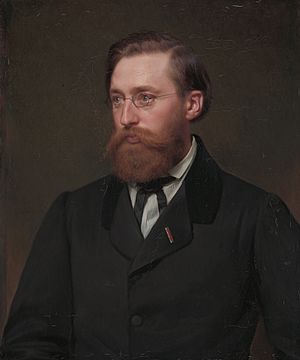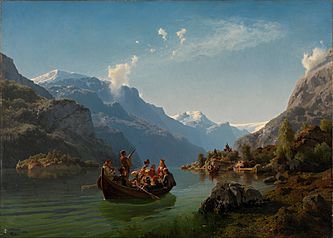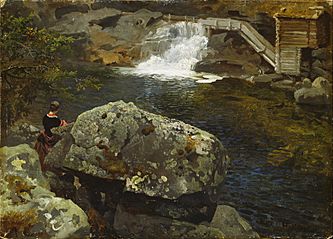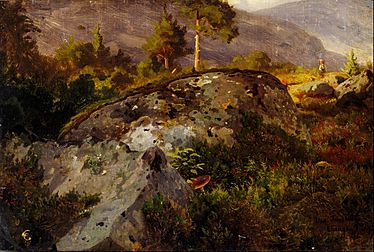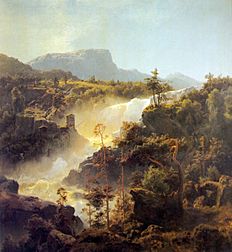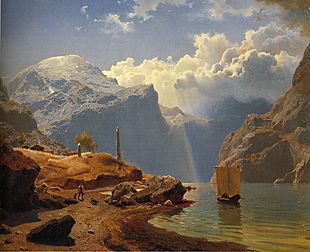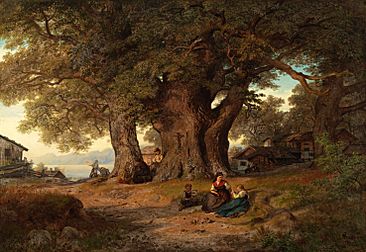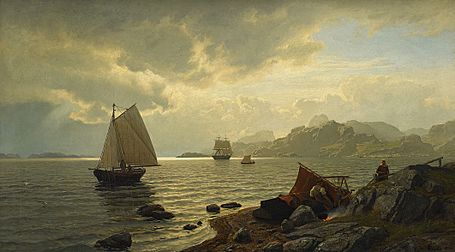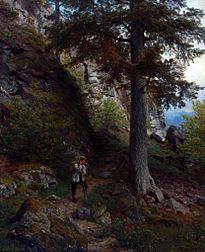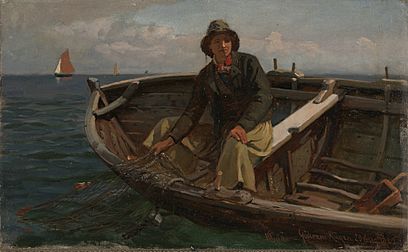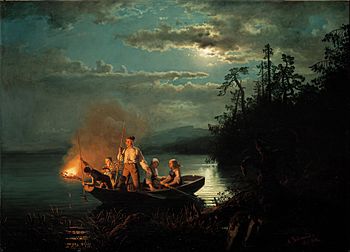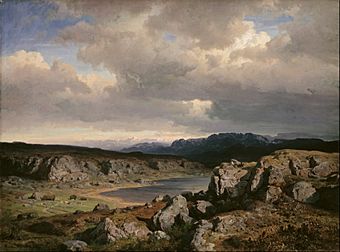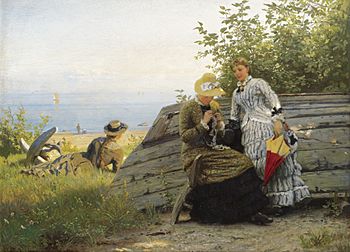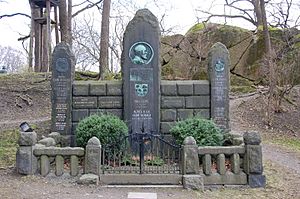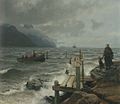Hans Gude facts for kids
Hans Fredrik Gude (born March 13, 1825 – died August 17, 1903) was a famous Norwegian painter. He is known for his beautiful landscape paintings. Many people consider him one of Norway's best landscape artists, along with Johan Christian Dahl. Gude was a key figure in a style called Norwegian romantic nationalism, which celebrated Norway's nature and culture. He was also part of the Düsseldorf school of painting.
Gude's art career grew steadily over time. He didn't make sudden, big changes. His early paintings showed peaceful, sunny Norwegian landscapes. They were romantic but also very realistic. Around 1860, Gude started painting seascapes and scenes of the coast.
At first, Gude found it hard to draw people well. So, he sometimes worked with another artist, Adolph Tidemand. Gude would paint the landscape, and Tidemand would add the people. Later, Gude practiced drawing figures more. He then started adding people to his own paintings.
Gude first used oil paints in his studio. He based his works on sketches he made outdoors. But as he became more experienced, he began painting en plein air, meaning directly outdoors. He encouraged his students to do this too. Later in life, Gude also used watercolors and gouache. He wanted to keep his art fresh and new. While his oil paintings were more popular, other artists admired his watercolors.
Gude taught art for 45 years. He played a big role in helping Norwegian art grow. He was a mentor to many young Norwegian artists. Students from Norway often traveled to where Gude was teaching. First, they went to the Academy of Art in Düsseldorf. Later, they followed him to the School of Art in Karlsruhe. Gude also taught at the Berlin Academy of Art from 1880 to 1901. However, fewer Norwegians went to Berlin then, as Paris had become more popular for young artists.
Throughout his life, Gude received many awards. He won medals and became an honorary member of several art academies. He was also given the Grand Cross of the Order of St. Olav. Hans Gude was the father of painter Nils Gude and watercolor artist Agnes Charlotte Gude. His daughter Sigrid married a German sculptor named Otto Lessing.
Contents
Early Life and Art Training
Hans Gude was born in Christiania (now Oslo) in 1825. His father, Ove Gude, was a judge.
Gude started his art journey with private lessons from Johannes Flintoe. By 1838, he was taking Flintoe's evening classes. These were held at the Royal School of Drawing in Christiania. In 1841, a writer named Johan Sebastian Welhaven suggested Gude should go to Düsseldorf. This was to help him learn even more about art.
Time at Düsseldorf Academy
At the Academy of Art in Düsseldorf, Gude met Johann Wilhelm Schirmer. Schirmer was a professor of landscape painting. At first, Schirmer told Gude to stop painting and go back to regular studies. Gude was not accepted into the academy right away. But he caught the eye of Andreas Achenbach, who gave him private lessons.
Becoming a Student
Gude was finally accepted into the academy in 1842. He joined Schirmer's landscape painting class. He quickly made great progress. The landscape painting class was new at the time. It started in 1839. Before that, figure painting (painting human bodies) was seen as more important. People thought true beauty could only be shown through the human form.
In his first semester, Gude got a "good" grade. He was called "talented." By his second year (1843–44), he was the only student described as "very talented." His report for his fourth year said he "paints Norwegian scenery in a truthful and distinctive manner."
While Gude was a student, two main styles of landscape painting were popular. One was the romantic style. It showed wild, untamed nature with dark forests and tall mountains. This style used strong colors and shadows. The other was the classical style. It focused on recreating landscapes from history or myths. This style used clear lines in its paintings. Gude learned about the romantic style from Achenbach. He learned about the classical style from Schirmer.
Gude also attended meetings of a "Society for Landscape Composition." Here, Schirmer gave advice on how to arrange elements in a painting. But as Gude's style became more realistic, he disagreed with some of Schirmer's ideas. He once said that Schirmer wanted him to make mountains look more "classical." But Gude wanted to paint them exactly as they were in real life.
In Düsseldorf, Gude became good friends with Carl Friedrich Lessing. Lessing painted dramatic historical scenes. Gude, however, never put historical events into his own paintings. Gude's oldest daughter later married one of Lessing's sons.
Gude worked as a student teacher at the academy until 1844. Then he moved back to Christiania. On July 25, 1850, Gude married Betsy Charlotte Juliane Anker. She was the daughter of General Erik Anker.
Becoming a Professor
In 1854, Gude became a professor of landscape painting at the academy. He took over from his old teacher, Schirmer. Gude was only 29, making him the youngest professor there. His appointment was partly because he was Norwegian. This made him a neutral choice in a conflict between different German regions.
Gude taught six hours of class each week. He also held office hours and helped supervise the figure drawing class. He attended staff meetings too. In 1857, Gude wanted to resign. He said it was for family reasons and his health. But in his memories, he mentioned problems with some students. Gude also felt that his pay was too low compared to other professors. He eventually left Düsseldorf five years later. Even though professors complained about teaching taking time from their art, Gude sold enough paintings to buy a house in Düsseldorf.
Norwegian or German Art?
By the mid-19th century, the Düsseldorf academy was popular for Norwegian artists. But people in Norway began to debate if this art was truly "Norwegian." They wondered if artists trained in Germany could still create Norwegian art. This discussion came up because there were plans to build an art school in Norway. Supporters of a Norwegian academy argued that artists needed to be trained at home.
Gude believed that Norwegian artists in Düsseldorf couldn't escape their heritage. He felt that Norway would always influence their art. He wrote that Norwegians shouldn't complain that artists abroad had forgotten their homeland. He said their Norwegian spirit was "firmly entrenched" in them.
However, the academy's director, Wilhelm von Schadow, argued that Gude's art was German. He said Gude's training was "totally German" and his style "unwontedly elevated."
Painting in Wales
| Eføybroen, Nord-Wales | |
|---|---|
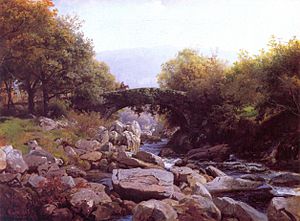 |
|
| Artist | Hans Gude |
| Year | 1863 |
| Medium | Oil on canvas |
| Dimensions | 41.5 cm × 55.5 cm (16.3 in × 21.9 in) |
| Location | National Gallery of Norway, Oslo |
Many of Gude's friends moved to other art schools. But Gude wanted to be closer to nature. He had already started selling his art in Britain in the 1850s. So, when an English art dealer suggested he might do well in England, Gude listened.
In 1862, Gude traveled to the Lledr Valley in Wales. This area was known for its beautiful scenery. Many British artists who painted en plein air (outdoors) already lived there. Gude was one of the first Norwegian artists to live this way. He rented a house overlooking the River Lledr. He painted an old Roman bridge there, which was popular with artists.
Gude noticed that British and Welsh painters often looked down on artists from Europe. They also had a different painting style. Gude and other European artists would make sketches outdoors. Then they would use these sketches to create finished paintings in their studios. But British and Welsh painters would set up their easels outdoors. They painted their artworks directly in front of their subjects.
Gude tried to gain respect from local painters. He showed his art at the Royal Academy's spring shows in London in 1863 and 1864. But these shows were not very successful. Gude called them "useful but bitter medicine." Even though the trip was expensive and he didn't sell many paintings, Gude felt it helped him grow as an artist. He wrote that being alone in a new landscape made him observe things more closely.
While in Wales, Gude was visited by Adolph Tidemand and Frederik Collett. The three artists traveled to Caernarvon and Holyhead. There, Gude saw his first real Atlantic storm.
Teaching at Karlsruhe
| Fra Chiemsee | |
|---|---|
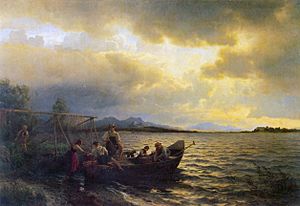 |
|
| Artist | Hans Gude |
| Year | 1868 |
| Medium | Oil on canvas |
| Dimensions | 145 cm × 208 cm (57 in × 82 in) |
| Location | Private Collection |
In December 1863, Gude was offered a professorship at the Baden School of Art in Karlsruhe. He accepted and left Wales. He was hesitant because he felt like he was working for a country that might soon be at war with Norway. But he couldn't support himself as an artist in Norway because there was no art school there.
When Gude accepted the job in Karlsruhe, Norwegian painters started going there instead of Düsseldorf. Many important Norwegian painters of the 1860s and 1870s studied with Gude in Karlsruhe. These included Frederik Collett, Kitty L. Kielland, Eilif Peterssen, and Frits Thaulow.
In Karlsruhe, Gude continued to paint landscapes exactly as he saw them. He taught this style to his students. He took them to Chiemsee to paint the lake outdoors. Gude also became very interested in how light reflected on water. He also worked on improving his human figures. Even though he rarely painted people as the main subject, he started adding realistic individuals to his scenes.
While in Karlsruhe, Gude painted Fra Chiemsee. This painting was shown in Vienna and was very popular. It was bought by a museum and won Gude several medals. He also became a member of the Academy of Fine Arts Vienna.
Gude had a good relationship with the Grand Duke of Baden, who founded the school. Because of this, Gude received better pay than in Düsseldorf. He had a large, free apartment and long breaks in the summer. These breaks allowed him to travel and make studies for future paintings. Gude was the director of Karlsruhe from 1866 to 1868 and again from 1869 to 1870. He introduced his own teaching ideas to help students develop their unique talents.
Later Years in Berlin
In 1880, Gude accepted a position at the Academy of Art in Berlin. He was chosen to lead the master studio for landscape painting. This job also gave him a place on the academy's Senate. Being on the Senate was a high honor.
In 1895, the Christiania Art Society held a big show of Gude's art. It included his paintings, oil studies, watercolors, and sketches. Gude felt that his studies and drawings were very important. By this time, Gude had changed his style. He was no longer painting huge works based on studies. He was using more gouache and watercolor. He wanted to keep his art "fresh." Other painters admired his watercolors, even though he didn't show them much.
Each summer, Gude spent a few weeks near the Baltic Sea. He found ideas for many paintings of Ahlbeck and Rügen there. He added more people to these paintings than his earlier works. But he still focused on showing the landscape accurately.
As the 19th century ended, many art academies faced new art movements. Gude supported his friend Anton von Werner in defending the traditional academies. He even made fun of the "so-called Symbolism" movement. As Gude got older, he felt it was harder to keep up with the changing art world. After a disappointing exhibition in Kristiania in 1902, Gude wrote that he felt "scorn" like many older artists. He knew that "modernists" wanted to take over the art scene.
In 1880, Gude had five to eight students. But by 1890, he only had two or three. This was partly because young artists were more interested in French art than German art.
Gude retired from the Berlin Academy in 1901. He passed away two years later in Berlin in 1903.
Artworks
Awards and Honors
- 1852 – Gold medal at Berlin Exhibition
- 1855 – Medal, 2nd class, Paris Exhibition
- 1860 – Gold medal at Berlin Exhibition
- 1861 – Medal, 2nd class, Paris Exhibition
- 1867 – Medal, 2nd class, Paris Exhibition
- 1873 – Gold medal at Vienna Exhibition for Nødhavn Ved Norskekysten
- 1876 – Medal for A Fresh Breeze, Norwegian Coast and Calm, Christianiaford in Philadelphia
- 1880 – Member of Berlin Academy of Art's Senate
- 1894 – Grand Cross of the Order of St. Olav
Gude was also a member of the Order of the Zähringer Lion, Order of the Red Eagle, and the Order of Franz Joseph.
Academy Memberships
Gude was a member of these art academies:
- Amsterdam
- Berlin
- Copenhagen
- Rotterdam
- Stockholm
- Vienna
Images for kids
See also
 In Spanish: Hans Gude para niños
In Spanish: Hans Gude para niños


